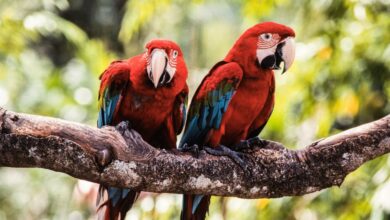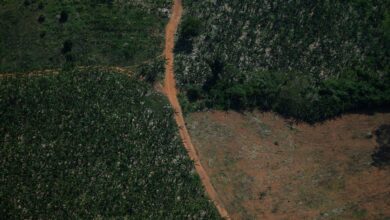
The ibis has a special place in ancient Egyptian history, as it was once associated with Thoth, an ancient Egyptian god and patron of writing, wisdom and magic, who was depicted as having the body of a man and the head of an ibis.
In ancient Egypt, millions of ibises were mummified and placed in tombs as offerings to the gods, and their sacredness was often recorded in ancient hieroglyphs.
Throughout Egypt’s marketplaces, one still finds an abundance of merchandise and goods bearing a depiction of the ibis, with many vendors maintaining that the bird symbolizes “good luck.”
Three species of ibis have been known to exist throughout Egypt: the Glossy Ibis, the Northern Bald Ibis and the African Sacred Ibis.
The Glossy Ibis, with its reddish brown body and slightly glossy green wings, can still be commonly found during winter throughout the Nile Delta; while the Northern Bald, with its black, majestic, yet vulture-like appearance, is not found in Egypt and is currently one of the most critically endangered birds on the planet.
But the species of ibis that was most valued to the ancient Egyptians was the African Sacred Ibis, which, despite being extinct in modern Egypt, still lives in abundance in sub-Saharan Africa.
It is this species of ibis, with its sharp but beautifully contrasting black and white appearance, that has received increased interest in recent years as cultural preservationists propose reintroducing the African sacred bird to Egypt.
“In terms of biology or natural history, it would be hard to argue a case for reintroducing the species into Egypt,” states Richard Hoath, British naturalist and author of “A Field Guide to the Mammals of Egypt.” “The justification to do so lies predominantly in the ibis’ sacred cultural and historical value."
The last reported sighting of the African Sacred Ibis was in 1891, and although unconfirmed sightings have continued, the general consensus is that the species is now extinct from modern Egypt.
Experts explain that it is difficult to isolate the exact causes of the sacred ibis’ disappearance, but a combination of human population increases, urban expansion, habitat destruction, breeding disturbances and active hunting are believed to have contributed to the loss.
Nature Conservation Egypt (NCE), an NGO dedicated to the conservation of Egypt’s natural heritage, has been piloting the project alongside a team of domestic and international experts. They warn that the process of reintroducing an ancient species is a highly complex and difficult task — and one that has never been done in Egypt before.
“We are now working on feasibility studies that aim to analyze the proposition and see whether or not such a reintroduction should even be attempted,” says Wael Shohdi, director of the reintroduction project at NCE.
After struggling to gain governmental authorization, the project was approved in 2010 and fieldwork began in May of this year. Some of the studies currently being conducted are an analysis of sacred ibis specimens living in northern Sudan, predictive analyses of habitat recreation around Lake Nasser in southern Egypt, and efforts to pinpoint reasons for the ibis' disappearance in Egypt.
Studying sacred ibises in northern Sudan will aid the reintroduction process, as the reintroduced specimens should be as genetically close as possible to the ibises that originally inhabited the area.
A reintroduction feasibility report was slated to be complete by March 2012, but due to turmoil in the country, a delay is expected.
“The research needs to be as comprehensive as possible because reintroducing the ibis is an extremely complex task,” says Shohdi.
“Natural reproduction habits need to be reproduced, and diversified gene pools need to be encouraged, in addition to providing the exact environmental conditions required for the ibis to survive on its own.”
Sacred ibises tend to enjoy marshy wetlands and mud flats, and require facilitated access to trees and small wildlife in order to lay eggs and feed their young ones. The careful selection of locations for reintroducing the species is crucial for the project to succeed.
Although it’s currently difficult for Shohdi to provide an exact timeline for the project, he explains that it will take many years to implement properly, assuming it passes the feasibility stage.
“It’s an enormous task with many obstacles,” concludes Shohdi. "But we are devoted to the challenge of restoring Egypt’s natural relationship with the ibis, in the hope that it will return to its historical home.”




